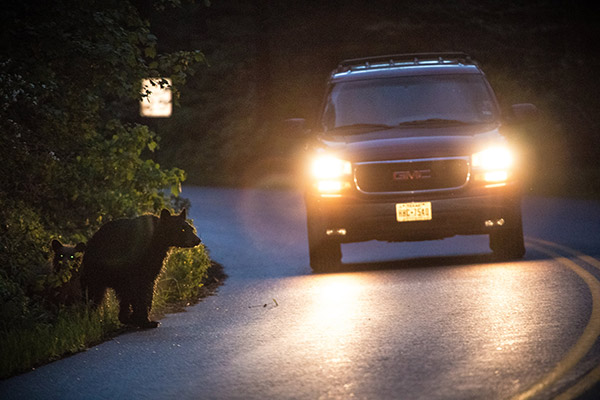Last updated: December 31, 2020
Lesson Plan
Turning Parks into Islands

- Grade Level:
- Upper Elementary: Third Grade through Fifth Grade
- Subject:
- Science
- Lesson Duration:
- 60 Minutes
- Additional Standards:
- NGSS 3-LS4-4. Make a claim about the merit of a solution to a problem caused when the environment changes and the types of plants and animals that live there may change.
Essential Question
What are ecosystem islands? What causes land fragmentation and ecosystem islands?
Objective
Students will be able to describe the effects of isolating wild areas into "islands".
Preparation
- Overhead transparencies
- Projector screen
- Road map of the area that includes the Y2Y region
Procedure
1. Write the facts about islands below on the board. Initiate discussion by asking students if they have ever visited an island. Inform them that they will be discussing the relationships between islands and extinction. Use the questions in italics to stimulate discussion.
Fact about islands:
The probablility of a species going extinct is higher if it lives on an island (and the smaller the island is, or the further it is from other land, the higher the probability of extinction - due to "The Area and Distance Effect," Song of the Dodo, David Quammen, 1996).
Why mainlanders have to worry about islands: -
As human development begins to surround our protected areas, these areas are turning into islands of habitat. Is it possible that we have already started to lose animals from our parks?
Why do you think that the size of an island and its distance from other land determines how fast species become extinct? Are "islands" always surrounded by water? Give some examples of land areas which act like islands. How about parks?
Extinction in parks:
Newmark (1987) discovered that many U.S. parks have already lost species. Bryce Canyon has lost: red fox, spotted skunk, white-tailed jackrabbit. Crater Lake has lost: river otter, spotted skunk, mink, and ermine. Mt. Rainier has lost: lynx, fisher, striped skunk (25% of resident mammals).
Headline: Species Vanishing from Many Parks
"Mammals are disappearing from North America's National Parks solely because the parks-even those covering hundreds of thousands of square miles-are too small to support them." (New York Times Editorial, 1987)
Do you know if the International Peace Park has lost any species? Are any species close to being gone? What are examples of animals who need lots of space?
Overhead 1910: Here is a park which was set aside in 1910 (the same year Glacier National Park was started). Was the area very populated? What do you think the rules were for the park back then? Why do you think the International Peace Park was started? Do you think the animals understood they were in a park?
Overhead 1950: What changed in the first 40 years of the park? Why did it change?
Overhead "Present": What has changed in the last 50 years? If you were a bear in this park, would you feel like you were on an island? Would you feel the same if you were a mouse or a warbler? Students may realize that there still exists a wild strip of land to the north of the park - which could serve as a corridor for larger animals if they needed to leave. List some effects of the development in and around the park. (road kill, habitat loss, more hunting outside the park, more people, pollution, large animal extinction, etc.) Do you think that the park is still run the way it was in 1910? What changes? Do you think people living next to the park like having it there? Everyone? Why?
2. Divide the students into management teams of three or four. A local politician comes to a staff meeting and shows some ideas they have for the future outside the park. Proposed changes chart.
Overhead "Future": Ask students to: (1) identify the changes that are proposed (2) come to a group decision on which developments they will approve (3) write their reasons for approval or disapproval and share them with the class Do you think it could be difficult for a park manager to disapprove of some changes? Why? Would the developments happen anyway? Why or why not? Are there any developments you know about proposed for the area outside W-GIPP?
3. Show students the linear densities map of the area around the International Peace Park. Explain that linear density is a measure the number of roads, powerlines, pipelines, and cleared areas. Can you find W-GIPP on this map? What is different outside and inside the park? Is there any advantage to keeping this Park connected to the other "green" areas on the map? (grizzlies, wolverines, elk, wolves, etc.)
Assessment Materials
Ask students write two reasons for and two reasons against a large highway underpass for animals to travel from W-GIPP to the Great Bear and Bob Marshall Wilderness areas.
Contact Information
Email us about this lesson plan
